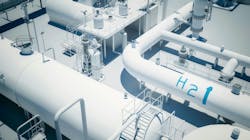DOE Clean Energy Demonstrations Office Awards Final Two Regional Green Hydrogen Hubs
The U.S. Department of Energy’s Office of Clean Energy Demonstrations (OCED) has awarded financial cost share totals to clean hydrogen hubs to finalize its nationwide commitment to a national hydrogen infrastructure.
The OCED awarded the Heartland Hydrogen Hub, led by the University of North Dakota Energy & Environmental Research Center (EERC), with $20 million (of the total federal cost share of up to $925 million) to initiate Phase 1 activities, which includes initial planning, design, and community and labor engagement activities.
The Heartland Hub plans to leverage new and existing energy resources and infrastructure to produce commercial-scale quantities of clean hydrogen to be used for American-made, low-carbon nitrogen fertilizer. This will increase supply in the region, lower costs for farmers, and reduce CO2 emissions by 525 thousand metric tons per year, equivalent to the annual emissions of more than 120,000 gasoline-powered cars.
Clean or green hydrogen is H2 generated by electrolyzers powered by carbon-free resources such as solar, wind, hydro and/or nuclear. Hydrogen itself does not contain carbon in its formula, so does not emit CO2 when combusted.
Additionally, OCED has awarded the Mid-Atlantic Hydrogen Hub, led by Mid-Atlantic Clean Hydrogen Hub (MACH2), with $18.8 million (of the total federal cost share of up to $750 million) to start Phase 1 activities. The Hub plans to develop hydrogen production facilities using both established and innovative electrolyzer technologies, which are expected to reduce costs and drive further technology adoption.
The clean hydrogen produced by the Hubs will be used in industrial applications like power generation and replacement fuel for process heaters and heavy-duty transportation, with several refueling stations planned to serve sanitation trash trucks, street sweepers, cargo handling equipment, and fuel cell electric buses. This will help minimize CO2 emissions by approximately 1 million metric tons per year, equivalent to the annual emissions of more than 220,000 gasoline-powered cars.
